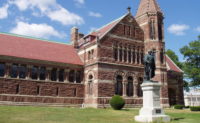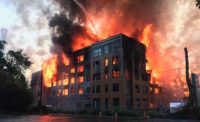The US Occupational Safety and Health Administration continues to investigate a building that partially collapsed on June 2 at a New Haven, Conn., construction site, injuring eight workers who fell two stories when a roughly 39-ft by-70-ft area of concrete collapsed beneath them,
City fire and building officials said six of the workers were released from Yale New Haven Hospital and two were in fair condition and continuing to receive treatment, according to a June 5 AP report. Officials said the crew was casting 4.2 million lb of concrete on the second level. About 3.2 million lb had accumulated at the time of the collapse.
Workers were spreading concrete “as it was being applied to that [second story] level,” New Haven Fire Chief John Alston, Jr. said during a recent news conference. Based on worker statements, the concrete “began to pull at a certain area faster than they could and caused it to cave on all the workers in that area,” he added.
The incident occurred at a jobsite for a seven-story, 112,000-sq-ft apartment building that includes 112-units and three levels of parking garage, two underground and one above ground. New Haven Mayor Justin Elicker said at the press conference that construction is being led by RMS, which owns the property and leases the land from Yale University, and also is the general contractor self-performing work.
"We will continue to work with our safety team and all of the appropriate government agencies to fully investigate the incident," said Randy Salvatore, RMS founder and CEO, said in a statement.
The New Haven Police Dept. is also conducting an investigation since serious injury was involved. OSHA has up to six months to complete its investigation.
Hard Rescue
When firefighters first arrived at the chaotic job site on June 2, they found six workers trapped within the collapse of wood forms, rebar and wet concrete, says Glenn Duda, fire photographer and president of the Connecticut Fire Photographers Association.
Alston said rescuing the workers before the concrete hardened was crucial. Rescue crews took “extreme care” with sharp rebar and one unstable wall, the fire chief added.
“Rescuers had to work fast, in dangerous conditions, to search for and extricate the injured workers,” Duda says. “Five workers were carried out via stokes baskets after being extricated. One worker was removed via a high point, hauling system set up using Truck One and ropes. It took firefighters about 45 minutes to extricate, package and remove this worker.”
Bad Form
The RMS project uses threaded screw jack reshores beneath the concrete, according to Robert Dillon, building official for New Haven’s Office of Building Inspection and Enforcement. “They post off the ground and hold the tension, and are placed through an RMS engineer drawing,” he says.
Orange, Conn.-based Seven Concrete was performing concrete work on the project, the city confirmed.
In 2022, the nonunion firm was issued three citations including two issued on Aug. 10 that involved fall protection systems criteria and practices and were serious violations, according to OSHA records. The first occurred on June 6, when an employee injured his shoulder and back after falling through a hole. It notes that "all covers were not color-coded or clearly marked" to provide a hazard warning. The second involved a worksite in Stamford, Conn. where the firm "did not ensure that all employees ... required to work in the building under construction at heights above six feet ... who were not protected from fall hazards were trained in fall hazards and the procedures ... to minimize such hazards." The firm was fined $10,151 and $7,252 respectively. Seven was also cited and fined $814 for abatement verification on Dec 1, 2022.
ENR was unable to reach a source at Seven for comment.
Moving Forward
RMS notified the city on June 6 that the New Haven building is safe to enter but the firm has to remove concrete and debris before a structural engineer can produce a plan on how to replace the collapsed slab.
Dillon says officials are still waiting for OSHA to determoine that the building is safe for the engineer to begin that analysis.
He is also reviewing proper cast-in-place construction procedures with contractors working on similar projects in the New Haven area, including the importance of reshoring. He aldo is making sure the books on each project are up to date and that the lines of communications between project teams and the city are open.
Dillon, who said RMS building permits were in order before the collapse, cannot recall any similar building collapses. “It is extremely unusual,” he says of the collapse. “It was a very unfortunate incident and I’m praying it was a one off that never happens again.”






Post a comment to this article
Report Abusive Comment